Filtration Performance Differences Between Single-Layer rGO Composite Materials and Commonly Used Combination Double-Layer Air Filter Materials Under Low-Carbon Targets
Abstract
1. Introduction
2. Methods
2.1. Selection of Materials
2.2. Performance Formula
2.3. Testing Equipment
3. Results and Discussion
3.1. Relevant Parameters of Materials
3.2. Distribution of Atmospheric Particulate Matter Concentration
3.3. The Impact of Filtration Velocity
3.4. Differences in Filtration Efficiency Under Different Particle Sizes
3.5. Differences in Resistance
3.6. Differences in Quality Factor
4. Conclusions
Author Contributions
Funding
Data Availability Statement
Conflicts of Interest
References
- Kaydi, N.; Jorfi, S.; Takdastan, A.; Haghighifard, N.J.; Khafaie, M.A. Morphological and chemical analysis of indoor airborne microplastics: Implications for human health in Ahvaz, Iran. Environ. Geochem. Health 2025, 47, 95. [Google Scholar] [CrossRef]
- Gilbert, J.A.; Hartmann, E.M. The indoors microbiome and human health. Nat. Rev. Microbiol. 2024, 22, 742–755. [Google Scholar] [CrossRef]
- Fan, H.; Zhao, C.; Yang, Y.; Yang, X. Rapid reduction of air pollution and short-term exposure risks in China. J. Environ. Sci. 2025, 149, 126–138. [Google Scholar] [CrossRef]
- Bagheri, G.; Schlenczek, O.; Turco, L.; Thiede, B.; Stieger, K.; Kosub, J.M.; Clauberg, S.; Pöhlker, M.L.; Pöhlker, C.; Moláček, J.; et al. Size, concentration, and origin of human exhaled particles and their dependence on human factors with implications on infection transmission. J. Aerosol Sci. 2023, 168, 106102. [Google Scholar] [CrossRef]
- Wang, Q.; Du, Z. Exploring the Coexistence Between New Quality Productive Force Developments, Human Capital Level Improvements and Time Poverty from a Time Utilization Perspective. Sustainability 2025, 17, 930. [Google Scholar] [CrossRef]
- Zacharias, N.; Haag, A.; Brang-Lamprecht, R.; Gebel, J.; Essert, S.M.; Kistemann, T.; Exner, M.; Mutters, N.T.; Engelhart, S. Air filtration as a tool for the reduction of viral aerosols. Sci. Total Environ. 2021, 772, 144956. [Google Scholar] [CrossRef]
- Asaoka, R.; Umishio, W.; Kagi, N.; Hayashi, M.; Sawachi, T.; Ueno, T. Office environments and worker satisfaction with thermal and air environments during and after the COVID-19 pandemic in Japan. Build. Environ. 2025, 268, 112349. [Google Scholar] [CrossRef]
- Bao, Y.Q.; Song, X.R.; Su, H.L.; Yu, Z.C.; Sun, Q.H.; Wang, Z.D. Optimal scheduling of combined air conditioner and fresh air system for price-based demand response. Sustain. Energy Grids 2025, 42, 101637. [Google Scholar] [CrossRef]
- Zhou, Z.; You, T.; Wang, D.; Pan, Z.; Xu, G.; Liang, Y.; Tang, M. Conformal build-up of functionalized air filters with improved air cleaning and bioprotective traps. Adv. Funct. Mater. 2024, 34, 2306777. [Google Scholar] [CrossRef]
- Berry, G.; Beckman, I.; Cho, H. A comprehensive review of particle loading models of fibrous air filters. J. Aerosol Sci. 2023, 167, 106078. [Google Scholar] [CrossRef]
- Yeganeh, F.; Chiewchan, N.; Chonkaew, W. Cellulose nanofiber/polyimide composites for highly-efficient air filters. Cellulose 2023, 30, 4421–4436. [Google Scholar] [CrossRef]
- Tian, X.; Ou, Q.; Pei, C.; Li, Z.; Liu, J.; Liang, Y.; Pui, D.Y. Effect of main-stage filter media selection on the loading performance of a two-stage filtration system. Build. Environ. 2021, 195, 107745. [Google Scholar] [CrossRef]
- Keyvani, S.; Golbabaei, F.; Neisiany, R.E.; Das, O.; Pourmand, M.R.; Kalantary, S. Filtration Performance of Biodegradable Electrospun Nanofibrous Membrane for Sub-Micron Particles: A Systematic Review. Macromol. Mater. Eng. 2025, 310, 2400323. [Google Scholar] [CrossRef]
- Garfansa, M.P.; Zalizar, L.; Husen, S.; Triwanto, J.; Iswahyudi, I.; Bakhtiar, A.; Lasaksi, P.; Ekalaturrahmah, Y.A.C. Addition of biochar based-activated carbon into sand filtration columns to improved removal efficiency microplastic from water. Bioresour. Technol. Rep. 2025, 30, 102099. [Google Scholar] [CrossRef]
- Gao, N.; Zhang, Y.; Chen, R.; Zhao, Y.; Li, X.P.; Li, H.; Shao, J.; Gao, J.; He, X.; Shi, B.; et al. Fully-biodegradable and self-powered intelligent filter assembled by fibrous cellulose and MOF-functionalized poly (lactic acid) core–shell nanofibers for active PM capturing and passive respiratory sensing. Int. J. Biol. Macromol. 2025, 31, 144118. [Google Scholar] [CrossRef]
- Pi, P.; Ren, Z.; Pan, L.; Lin, Y.; Yang, Y.; Li, Y. Composite dimensional structure superhydrophilic-underwater superoleophobic material for efficient separation of oil-in-water emulsions. Sep. Purif. Technol. 2025, 362, 131623. [Google Scholar] [CrossRef]
- Nie, J.; Sun, B.; Jiao, T.; Liao, J.; Zhang, M.; Yang, R.; Li, Y. Biodegradable air filter with electrospun composite nanofibers and cellulose fibers dual network: Enhanced electrostatic adsorption, humidity resistance, and extended service life. J. Hazard. Mater. 2025, 489, 137557. [Google Scholar] [CrossRef]
- Yan, N.; Gao, T.; Hua, L.; Xie, F.; Liu, R.X.; Hu, D.G.; Lu, Z.Q. Highly electrostatic cellulose acetate materials assisted by copper ion coordination for air filtration. Chem. Eng. J. 2025, 505, 159848. [Google Scholar] [CrossRef]
- Wu, Z.-T.; Chen, X.; Li, G.-X.; Tian, L.; Wang, Z.; Xiong, X.-Q.; Yang, C.; Zhou, Z.-J.; Pan, X.-C. Attributable risk and economic cost of hospital admissions for mental disorders due to PM2.5 in Beijing. Sci. Total Environ. 2020, 718, 137274. [Google Scholar] [CrossRef]
- Bian, Y.; Niu, Z.-L.; Wang, S.-J.; Pan, Y.; Zhang, L.; Chen, C. Removal of Size-Dependent Submicron Particles Using Metal–Organic Framework-Based Nanofiber Air Filters. ACS Appl. Mater. Interfaces 2022, 14, 23570–23576. [Google Scholar] [CrossRef]
- Xu, C.; Jiang, L.; Zhang, Y.; Zhu, G.; Zhu, X.; Zhao, Y.; Li, X.P.; Zhang, S.; Li, H.; Xu, L.; et al. Lotus leaf-inspired poly (lactic acid) nanofibrous membranes with enhanced humidity resistance for superefficient PM filtration and high-sensitivity passive monitoring. J. Hazard. Mater. 2025, 488, 137516. [Google Scholar] [CrossRef]
- Abbas, W.A.; Shaheen, B.S.; Ghanem, L.G.; Badawy, I.M.; Abodouh, M.M.; Abdou, S.M.; Zada, S.; Allam, N.K. Cost-Effective Face Mask Filter Based on Hybrid Composite Nanofibrous Layers with High Filtration Efficiency. Langmuir 2021, 37, 7492–7502. [Google Scholar] [CrossRef]
- Chen, C.; Shen, L.; Wang, B.; Lu, X.; Raza, S.; Xu, J.; Li, B.; Lin, H.; Chen, B. Environmental applications of metal–organic framework-based three-dimensional macrostructures: A review. Chem. Soc. Rev. 2025, 54, 2208–2245. [Google Scholar] [CrossRef]
- Zhang, X.; Ma, J.Y.; Nie, X.X.; Fan, Y.S.; Wang, H.; Cui, Y. Establishment of air fiber filtration model based on fractal theory and analysis of filtration performances. Mater. Today Commun. 2023, 34, 105301. [Google Scholar] [CrossRef]
- Lin, X.; Sun, W.; Lin, M.; Chen, T.; Duan, K.; Lin, H.; Zhang, C.; Qi, H. Bicomponent core/sheath melt-blown fibers for air filtration with ultra-low resistance. RSC Adv. 2024, 14, 14100–14113. [Google Scholar] [CrossRef] [PubMed]
- Meng, H.; Liu, J.; Shang, W.; Xu, J.; Jia, L. Multi-Agent Distributed Control Method for Clean Air-Conditioning Systems: Balancing Cleanliness, Pressure and Energy Consumption. J. Build. Eng. 2025, 107, 112806. [Google Scholar] [CrossRef]
- Park, S.S.; Lee, Y.S.; Lee, S.W.; Repo, E.; Kim, T.H.; Park, Y.; Hwang, Y. Facile Surface Treatment of 3D-Printed PLA Filter for Enhanced Graphene Oxide Doping and Effective Removal of Cationic Dyes. Polymers 2023, 15, 269. [Google Scholar] [CrossRef]
- Shi, S.; Bai, W.; Chen, X.; Si, Y.; Zhi, C.; Wu, H.; Su, Y.; Cai, W.; Fei, B.; Kan, C.W.; et al. Advances in nanofiber filtration membranes: From principles to intelligent applications. Adv. Funct. Mater. 2025, 35, 2423284. [Google Scholar] [CrossRef]
- Jepleting, A.; Mecha, A.C.; Sombei, D.; Moraa, D.; Chollom, M.N. Potential of low-cost materials for biogas purification, a review of recent developments. Renew. Sustain. Energy Rev. 2025, 210, 115152. [Google Scholar] [CrossRef]
- Mortazavi, B. Recent advances in machine learning-assisted multiscale design of energy materials. Adv. Energy Mater. 2025, 15, 2403876. [Google Scholar] [CrossRef]
- Grubman-Nowak, M.; Szafran-Dobrowolska, J.; Jeżewska, M.; Renke, M. Quality of life, well-being and job satisfaction of people working at sea: Analysis of working conditions pre and post COVID-19 pandemic. Int. Marit. Health Found. 2025, 76, 20. [Google Scholar]
- Zhang, T.; Lv, J.J.; Dang, Y.; Gao, Z.; Wang, H.; Cao, J.W.; Zhang, G.H.; Rao, H.; Pan, F.P.; Chen, K.J. High-throughput computational screening-driven porous material discovery for benchmark propylene/propane separation. Adv. Funct. Mater. 2025, 35, 2412457. [Google Scholar] [CrossRef]
- Behroozi, A.H.; Meunier, L.; Mirahsani, A.; Champagne, P.; Koupaie, E.H. Graphene-based materials and technologies for the treatment of PFAS in water: A review of recent developments. J. Hazard. Mater. Adv. 2025, 17, 100626. [Google Scholar] [CrossRef]
- Yu, Y.; Liu, X.; Lu, D.; Liu, T.; Li, Y.; Wu, Z. Recent progress in graphene based materials for high-performance electromagnetic shielding. Carbon 2025, 236, 120093. [Google Scholar] [CrossRef]
- Guo, E.; Zhang, W.; Lai, J.; Hu, H.; Xue, F.; Su, X. Enhancement of Cement-Based Materials: Mechanisms, Impacts, and Applications of Carbon Nanotubes in Microstructural Modification. Buildings 2025, 15, 1234. [Google Scholar] [CrossRef]
- Sun, Z.; Wang, Y.; Jiang, X.; Bando, Y.; Wang, X. 3D network of graphene materials for alkali metal ion batteries. EnergyChem 2025, 7, 100149. [Google Scholar] [CrossRef]
- Feng, W.; Sui, X.; Zhu, J.; Meng, C.; Li, Y.; Guo, X.; Wu, B.; Wang, Z. Bifunctional surface engineering of reduced graphene oxides to overcome electrode mismatch in sodium-ion hybrid capacitors. J. Power Sources 2025, 644, 237155. [Google Scholar] [CrossRef]
- Nassar, A.A.; Mubarak, M.F.; El-Sawaf, A.K.; Zayed, M.A.; Hemdan, M. Efficient lead ion removal from aqueous solutions for wastewater treatment using a novel cross-linked alginate-rice husk ash-graphene oxide-chitosan nanocomposite. Int. J. Biol. Macromol. 2025, 284, 137983. [Google Scholar] [CrossRef] [PubMed]
- Demir, G.; Gezmis-Yavuz, E.; Zembat, A.A.; Koseoglu-Imer, D.Y.; Cansoy, C.E. Fabrication of electrospun graphene-oxide embedded polyacrylonitrile composite nanofibers for air filtration. J. Macromol. Sci. A 2025, 62, 371–377. [Google Scholar] [CrossRef]
- Kanchana, V.; Vasanthan, S.; Mayavan, L.; Kistan, A. A novel mesoporous Al2O3@ Graphene composite as photocatalyst for organic pollutant removal. J. Electron. Mater. 2025, 54, 2122–2134. [Google Scholar] [CrossRef]
- Wong, S.J.; Tan, H.; Kek, H.Y.; Othman, M.H.D.; Woon, K.S.; Wang, X.C.; Samad, W.M.A.W.A.; Wong, K.Y. Optimizing indoor air quality: Evaluating the synergistic impact of filter integration and botanical solutions. Clean Technol. Environ. Policy 2025, 1–25. [Google Scholar] [CrossRef]
- Liu, S.; Dun, C.; Jiang, Q.; Xuan, Z.; Yang, F.; Guo, J.; Urban, J.J.; Swihart, M.T. Challenging thermodynamics: Combining immiscible elements in a single-phase nano-ceramic. Nat. Commun. 2024, 15, 1167. [Google Scholar] [CrossRef]
- Li, H.; Bi, S.; Cai, J.; Chu, X.; Hou, G.; Zhang, J.; Wu, T. Reduced graphene oxide/nonwoven fabric filled honeycomb composite structure for broadband microwave absorption. Carbon 2024, 223, 119005. [Google Scholar] [CrossRef]
- Wu, X.; Zhang, X.; Yu, X.; Liang, H.; Tang, S.; Wang, Y. Exploring the association between air pollution and the incidence of liver cancers. Ecotoxicol. Environ. Saf. 2025, 290, 117437. [Google Scholar] [CrossRef] [PubMed]
- Tajik, S.; Jahangir, M.H. Innovative design, fabrication, and evaluation of an integrated smart green facade and photovoltaic: A double-layer air circulation system for air retention time expose to plants and PV cooling to enhance air purification. Energy Rep. 2025, 13, 4015–4033. [Google Scholar] [CrossRef]
- Shafagh, S.G.; Kaatuzian, H.; Danaie, M. Design and analysis of optical devices with ultra-high quality factor based on a plasmonic photonic hybrid structure. Eng. Res. Express 2025, 7, 015356. [Google Scholar] [CrossRef]
- Wu, S.; Zhang, Z.; Chen, J.; Yao, Y.; Li, D. Characterisation of stress corrosion durability and time-dependent performance of cable bolts in underground mine environments. Eng. Fail. Anal. 2023, 150, 107292. [Google Scholar] [CrossRef]
- Wang, X.; Qiu, Z.; Gu, Q.; Wang, H.; Guo, J.; Li, X.; Deng, K.; Zhang, Y.; Zhang, C.; Jiang, H.; et al. Wear failure of pipelines transporting cemented paste backfill: A review. Physics of Fluids. 2025, 37, 071309. [Google Scholar] [CrossRef]
- Wu, S.; Ma, X.; Zhang, X.; Chen, J.; Yao, Y.; Li, D. Investigation into hydrogen induced fracture of cable bolts under deep stress corrosion coupling conditions. Tunn. Undergr. Space Technol. 2024, 147, 105729. [Google Scholar] [CrossRef]
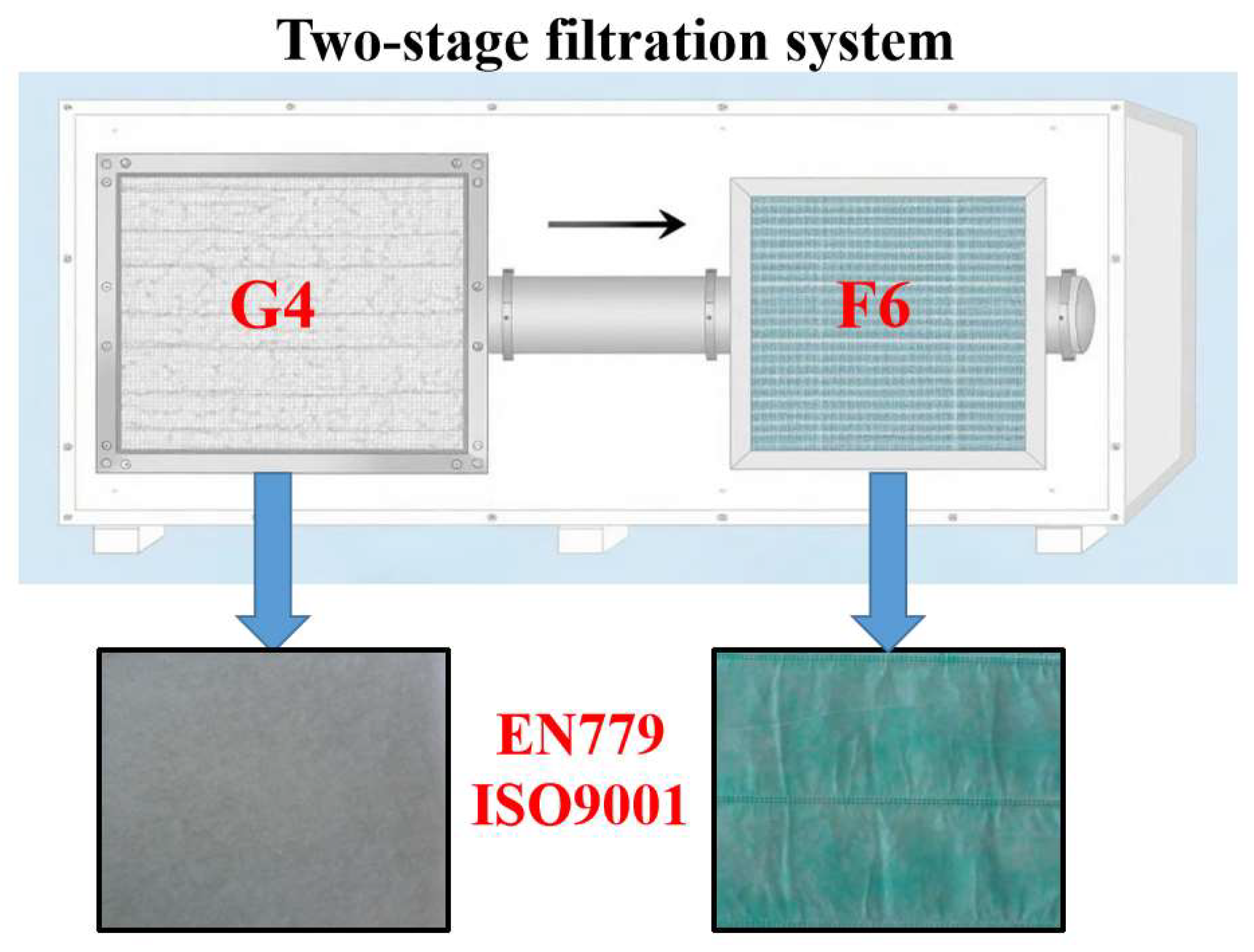


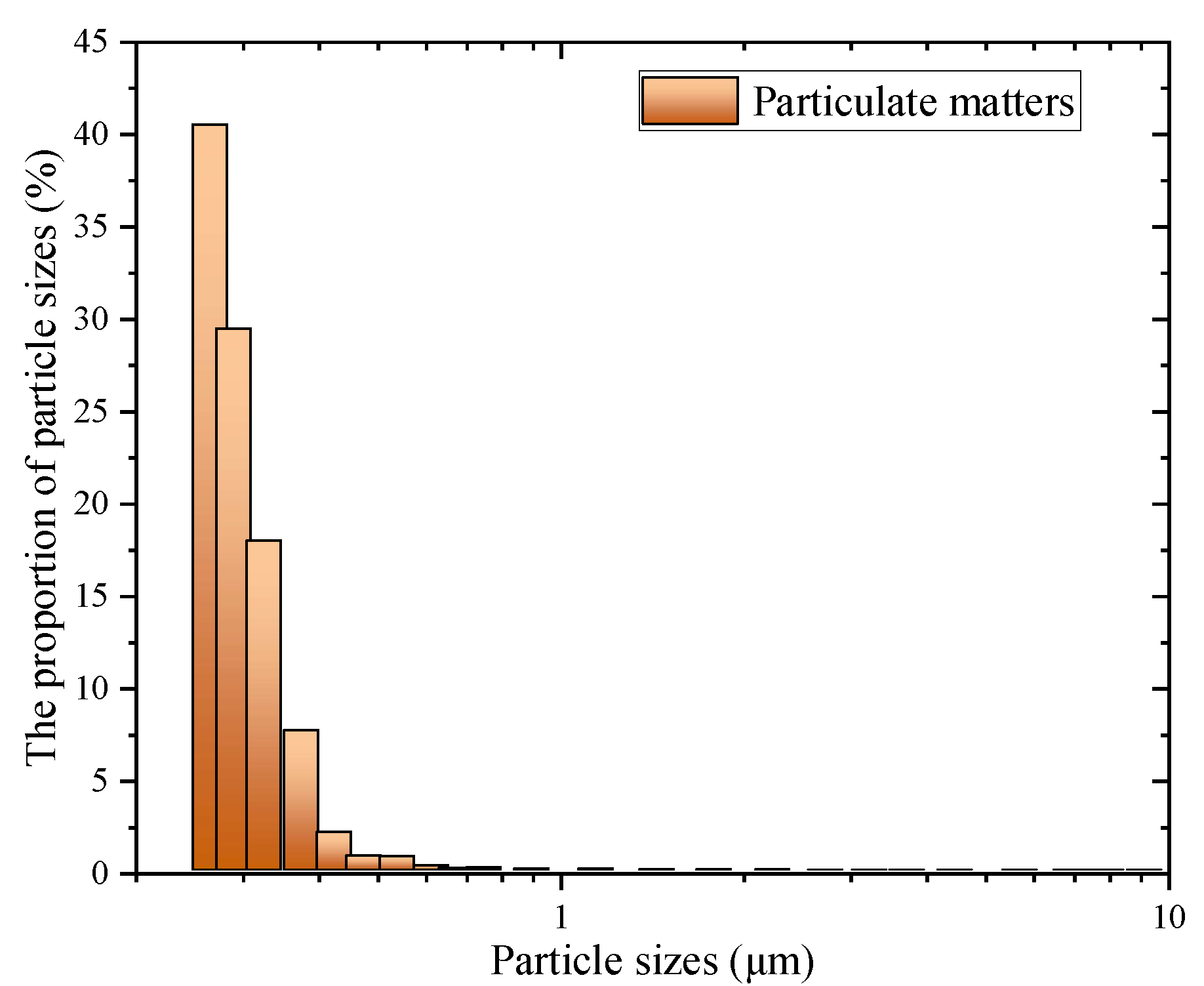
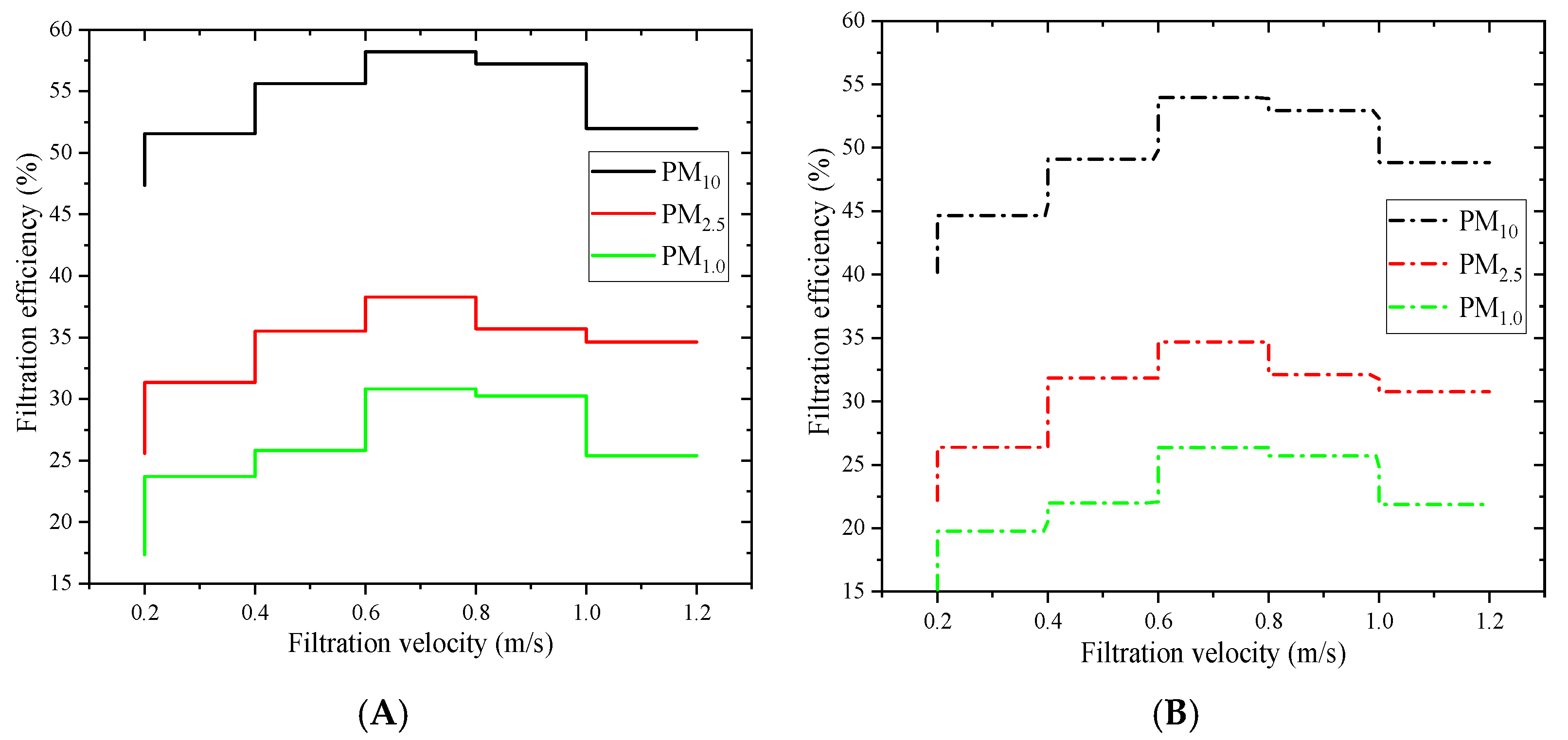
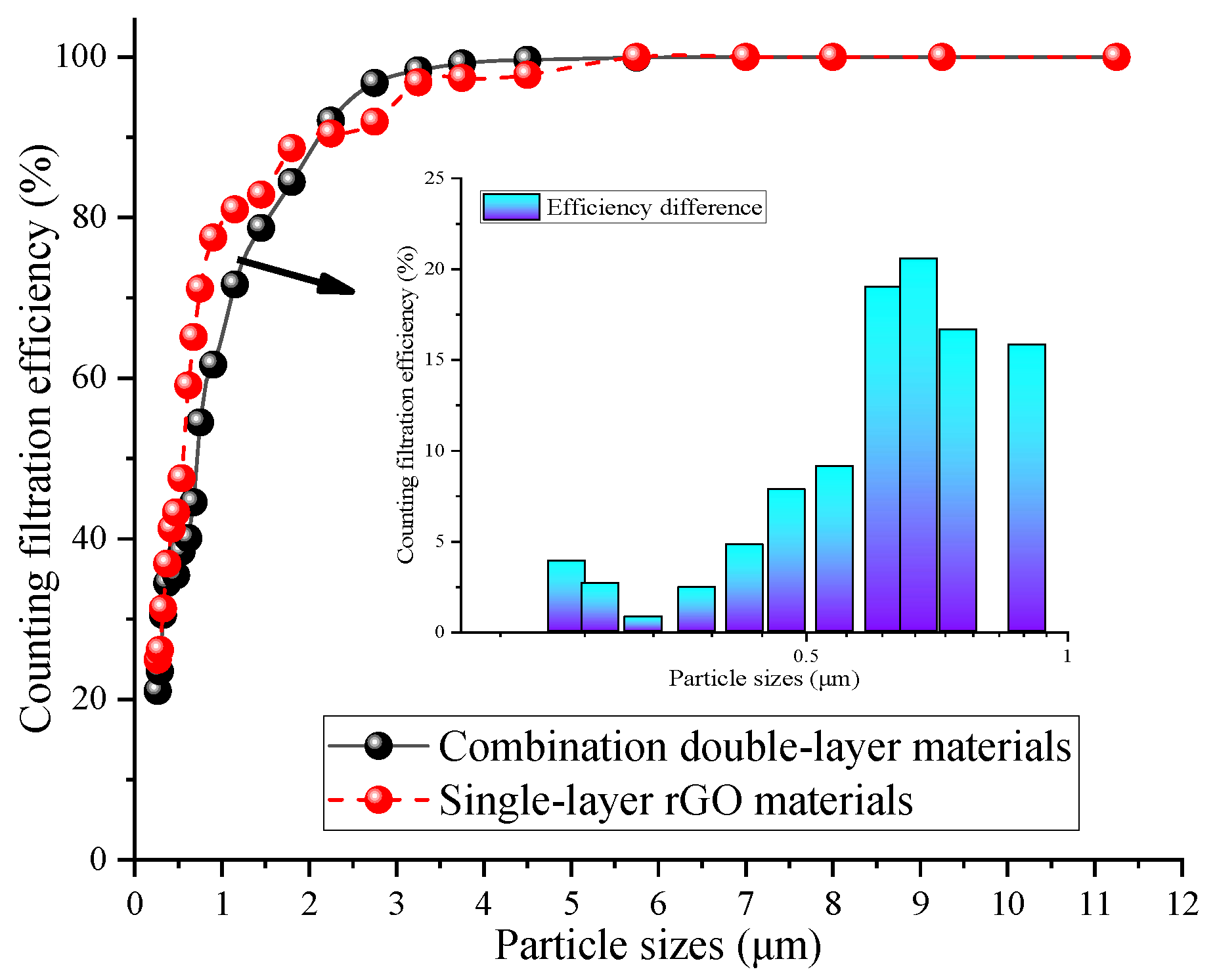

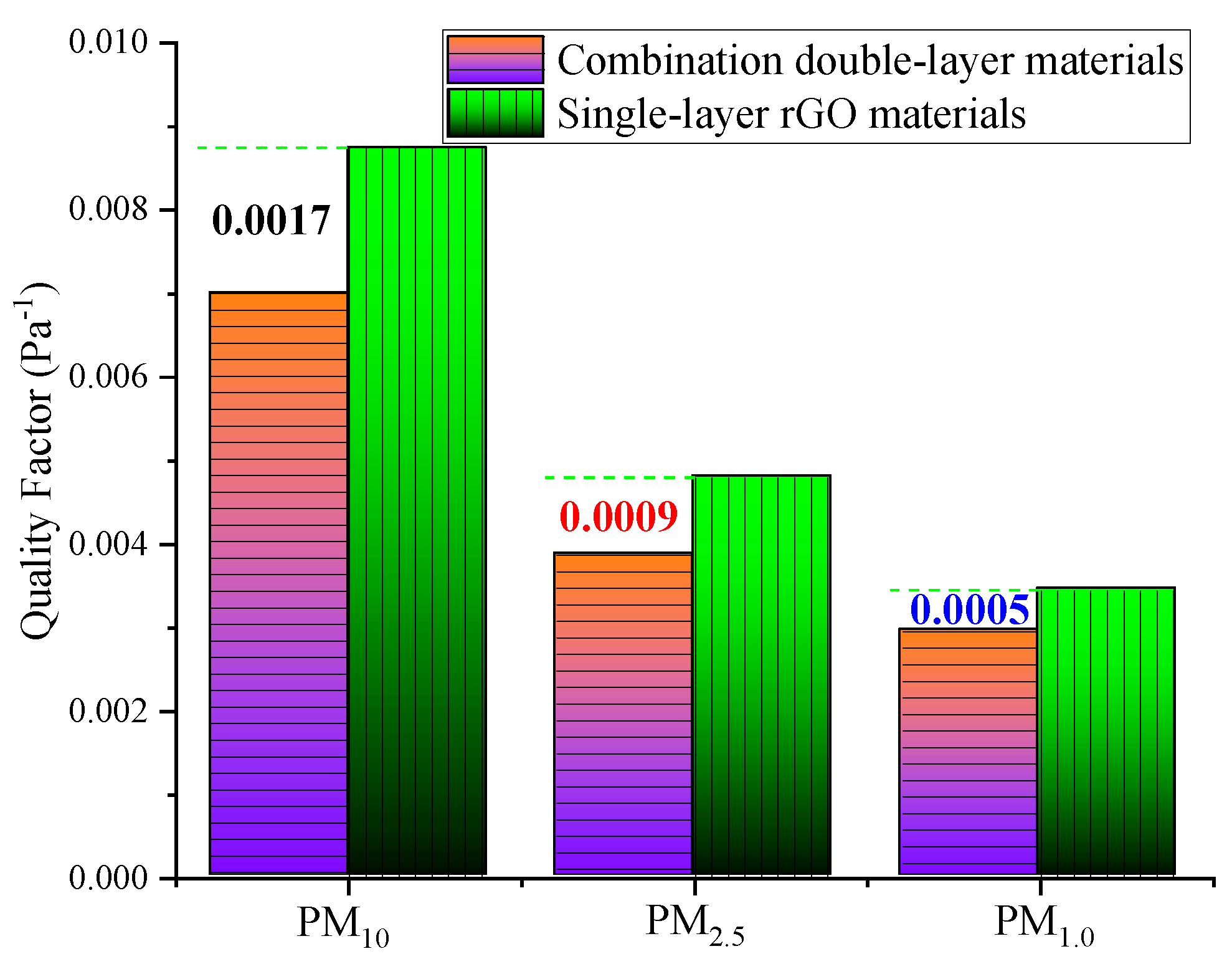
| Sample | Size (cm) | Fiber Diameter (μm) | Filling Rate (%) | Porosity (%) |
|---|---|---|---|---|
| G4 | 25 × 25 × 20.00 | 32.12 ± 0.02 | 1.87 ± 0.02 | 98.13 ± 0.02 |
| F6 | 25 × 25 × 7.00 | 27.64 ± 0.03 | 3.91 ± 0.03 | 96.09 ± 0.03 |
| rGO | 25 × 25 × 7.86 | 21.86 ± 0.03 | 5.74 ± 0.03 | 94.26 ± 0.03 |
Disclaimer/Publisher’s Note: The statements, opinions and data contained in all publications are solely those of the individual author(s) and contributor(s) and not of MDPI and/or the editor(s). MDPI and/or the editor(s) disclaim responsibility for any injury to people or property resulting from any ideas, methods, instructions or products referred to in the content. |
© 2025 by the authors. Licensee MDPI, Basel, Switzerland. This article is an open access article distributed under the terms and conditions of the Creative Commons Attribution (CC BY) license (https://creativecommons.org/licenses/by/4.0/).
Share and Cite
Wei, W.; Xu, F.; Zhang, X. Filtration Performance Differences Between Single-Layer rGO Composite Materials and Commonly Used Combination Double-Layer Air Filter Materials Under Low-Carbon Targets. Processes 2025, 13, 2746. https://doi.org/10.3390/pr13092746
Wei W, Xu F, Zhang X. Filtration Performance Differences Between Single-Layer rGO Composite Materials and Commonly Used Combination Double-Layer Air Filter Materials Under Low-Carbon Targets. Processes. 2025; 13(9):2746. https://doi.org/10.3390/pr13092746
Chicago/Turabian StyleWei, Wei, Fumin Xu, and Xin Zhang. 2025. "Filtration Performance Differences Between Single-Layer rGO Composite Materials and Commonly Used Combination Double-Layer Air Filter Materials Under Low-Carbon Targets" Processes 13, no. 9: 2746. https://doi.org/10.3390/pr13092746
APA StyleWei, W., Xu, F., & Zhang, X. (2025). Filtration Performance Differences Between Single-Layer rGO Composite Materials and Commonly Used Combination Double-Layer Air Filter Materials Under Low-Carbon Targets. Processes, 13(9), 2746. https://doi.org/10.3390/pr13092746






